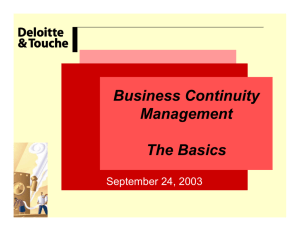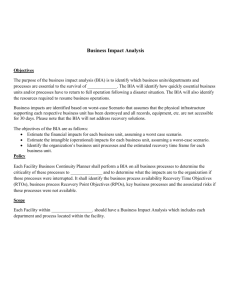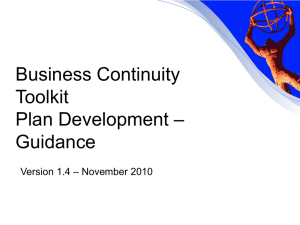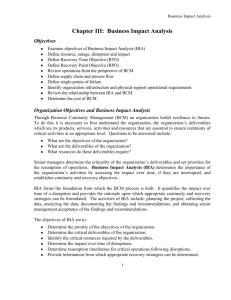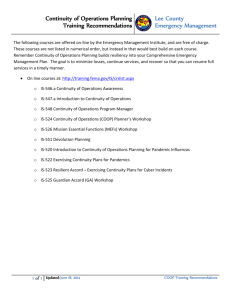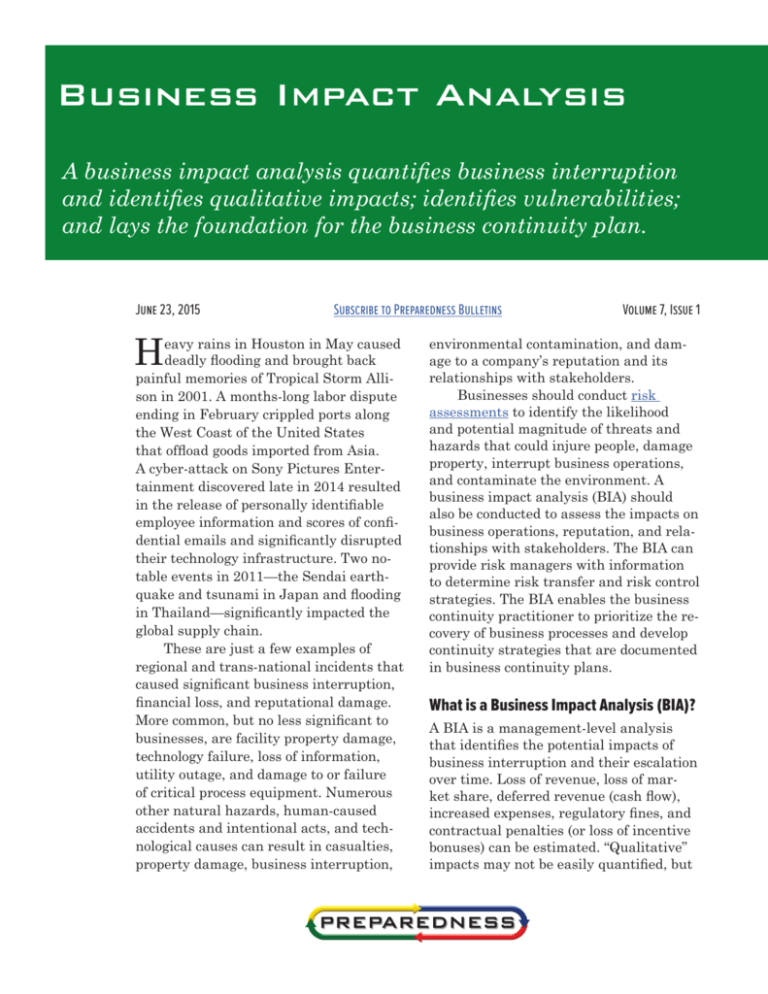
Business Impact Analysis
A business impact analysis quantifies business interruption
and identifies qualitative impacts; identifies vulnerabilities;
and lays the foundation for the business continuity plan.
June 23, 2015
H
Subscribe to Preparedness Bulletins
eavy rains in Houston in May caused
deadly flooding and brought back
painful memories of Tropical Storm Allison in 2001. A months-long labor dispute
ending in February crippled ports along
the West Coast of the United States
that offload goods imported from Asia.
A cyber-attack on Sony Pictures Entertainment discovered late in 2014 resulted
in the release of personally identifiable
employee information and scores of confidential emails and significantly disrupted
their technology infrastructure. Two notable events in 2011—the Sendai earthquake and tsunami in Japan and flooding
in Thailand—significantly impacted the
global supply chain.
These are just a few examples of
regional and trans-national incidents that
caused significant business interruption,
financial loss, and reputational damage.
More common, but no less significant to
businesses, are facility property damage,
technology failure, loss of information,
utility outage, and damage to or failure
of critical process equipment. Numerous
other natural hazards, human-caused
accidents and intentional acts, and technological causes can result in casualties,
property damage, business interruption,
Volume 7, Issue 1
environmental contamination, and damage to a company’s reputation and its
relationships with stakeholders.
Businesses should conduct risk
assessments to identify the likelihood
and potential magnitude of threats and
hazards that could injure people, damage
property, interrupt business operations,
and contaminate the environment. A
business impact analysis (BIA) should
also be conducted to assess the impacts on
business operations, reputation, and relationships with stakeholders. The BIA can
provide risk managers with information
to determine risk transfer and risk control
strategies. The BIA enables the business
continuity practitioner to prioritize the recovery of business processes and develop
continuity strategies that are documented
in business continuity plans.
What is a Business Impact Analysis (BIA)?
A BIA is a management-level analysis
that identifies the potential impacts of
business interruption and their escalation
over time. Loss of revenue, loss of market share, deferred revenue (cash flow),
increased expenses, regulatory fines, and
contractual penalties (or loss of incentive
bonuses) can be estimated. “Qualitative”
impacts may not be easily quantified, but
PREPAREDNESS
Business Impact Analysis
page 2
they are no less important. Delayed delivery of products or services to customers,
defective products, and customer service
issues can jeopardize long-standing relationships. If an incident becomes a headline in the media or incurs the scrutiny
of government officials, then reputation
management becomes an overarching concern. Potential impacts on employees and
the environment must also be assessed.
Business continuity planning is
focused on recovering business functions
and processes at minimally acceptable
levels within predetermined time periods
to avoid unacceptable impacts. The BIA
provides the information to:
■■ Prioritize the recovery of business
functions and processes based on their
relative contributions to the business.
■■ Define the time periods for recovery.
■■ Identify the resources required to support business functions and processes
at a minimally acceptable level.
■■ Develop continuity strategies and document business continuity plans.
Terminology
Two business continuity terms define the
limits of acceptable downtime and data
loss—“recovery time objective” (RTO) and
“recovery point objective” (RPO).
RTO is defined as the maximum duration that a process can be interrupted before the resulting impacts are deemed by
business management to be unacceptable.
Business functions (e.g., finance) and processes that comprise each function (e.g.,
accounts receivable, accounts payable,
etc.) may have varying RTOs. When RTOs
are compiled and sorted from shortest duration to longest duration, the recovery of
business functions and processes is prioritized (i.e., process with the shortest RTO
is recovered first).
The timing of potential business
interruption is also part of the analysis.
If an interruption occurs at a seasonal
peak in business operations—for example
retailers during the holiday shopping season—then the impacts could be amplified.
There are numerous deadlines associated
with contractual obligations, regulatory requirements, and financial matters.
Deadlines and peaks in business operations provide information that can be used
to re-prioritize continuity and recovery
efforts at the time of loss and can also be
used to implement enhanced loss prevention measures at critical times.
RPO is a determination of the maximum amount of data that can be lost
without causing unacceptable impacts.
Businesses have numerous computer applications each with associated data. The
volume of data generated every minute
and hour can be substantial for businesses handling high volumes of transactions.
New data and data changed since the
last accessible and restorable backup
can be lost if the building, room, or hardware hosting the data is damaged; data
is corrupted; or if data is accidentally or
intentionally deleted. Data can be backed
up using a variety of methods and media.
Backup schedules vary from continuous
to every day or longer depending upon the
criticality of the data. The method and
frequency of data backup and the location of the backup media will determine
the amount of time that it would take to
recover data. Data synchronized with another site may be continuously available,
whereas a series of daily incremental and
weekly backups to media that is stored
at a commercial vendor may take many
hours or days to restore.
Resources are at the core of business
continuity planning are continuity strategies that can be executed to continue
time-sensitive business processes at
minimum acceptable levels. The identification of resources required to continue
business processes is a significant aspect
of the business impact analysis. Resources
include qualified people, facilities (and
supporting infrastructure), machinery and
PREPAREDNESS
Business Impact Analysis
page 3
equipment, technology, and supply chain
(goods and services). The shorter the RTO
or the lower the tolerable amount of data
loss (RPO), the more robust the planning
for, and provision of, resources to achieve
the recovery objective.
Planning The BIA
Careful planning of the business impact
analysis can ensure that accurate information is consistently developed thereby
providing a solid foundation for determination of recovery priorities and investments in resources to support continuity
strategies. A business continuity practitioner with strong leadership, project
management, interpersonal, communication, and technology skills is essential.
Scope
The scope of the business impact analysis
should be approved by management. Options include the enterprise, single business unit, or a single product or service
line. Product lines or services that generate significant revenue or profit margin
would be priorities for analysis. Other
products or services should be included if
they have growth potential or are a required part of a “bundle” with high priority products or services. Analysis of a product or service line that involves multiple
facilities would require an analysis of the
dependencies between facilities.
Senior operations and finance managers should be able to identify critical
lines of business. A facilitated planning
session that flowcharts business processes, dependencies, and interdependencies
for each product or service line and their
associated revenue is an excellent way to
determine the BIA scope. As the flowchart
is developed, persons with the institutional knowledge of the processes that
support products and service lines should
be identified. These persons will complete
questionnaires during the data collection
phase.
Planning Assumptions & Scenarios
A common question about business continuity planning is “How many scenarios
should be planned for?” In contrast to
emergency planning for life safety and
property conservation where the cause
usually dictates the scope of the response,
business continuity planning addresses
impacts rather than what caused the
impacts. Therefore, the assumption that
underlies the business impact analysis
is the facility that houses the business
function and processes is not available
and all resources to continue the process
must be available elsewhere. Causes or
scenarios that caused the business interruption would be considered when potential continuity strategies are evaluated
and the availability of capable resources
is determined.
Criteria
During the business impact analysis process “owners” are asked about the potential severity of impacts resulting from the
downtime of their business process. It’s
not enough to use subjective ratings such
as low, medium, or high. Impact ratings
should be defined using a combination
of quantifiable and qualitative criteria.
Quantifiable monetary thresholds include
lost revenue from production downtime or
lost sales associated with the interruption
of incoming calls to customer service and
sales representatives. Qualitative impacts
could include product or service quality issues or delays affecting customer relationships. Management should approve the
criteria used to define the level of impacts.
The criteria for rating impacts, time
periods for downtime before impacts, time
periods for recovery time objectives, and
related fields can be programmed into the
BIA questionnaires.
PREPAREDNESS
Business Impact Analysis
page 4
Resource Requirements
The BIA should capture detailed information about the minimum, qualified
resources required to sustain a critical
business process (see text box below for
list). The BIA questionnaire should be
structured so that process owners select
from pre-populated lists that will ensure
that resources will be consistently identified by the same name spelled the same
way. Each resource becomes a “record”
that can be compiled into a master database and sorted using unique resource
names. For example, if process owners are
asked to manually input names for computer applications, “MS Office” would be
sorted differently than “Microsoft Office.”
Master lists of resources including computer applications, suppliers, and machinery and equipment can be exported from
other databases and built into database
applications including Microsoft Excel.
Resource Requirements
✓✓ People
✓✓ Facilities and required infrastructure (space, utilities, etc.)
✓✓ Machinery and customizations (fixtures, tooling, dies,
molds, etc.)
sorting by RTO to identify gaps between
IT’s recovery capabilities and process
owners’ needs for application recovery.
Conducting the BIA
The process for conducting a BIA is presented in text box below. A business impact analysis is typically conducted using
questionnaires and interviews to gather
information from the owners of business
processes that are most familiar with
them. Questionnaires may be integrated
into commercially available business continuity planning software. These products are relational databases using the
questionnaires to populate the database,
and the software aggregates and presents
information for analysis. Questionnaires
can also be constructed using a combination of documents and spreadsheets that
are compiled manually. Regardless of the
tools used to capture information, the
process requires structuring the tools to
capture information specific to the business operations.
BIA Methodology
✓✓ Equipment (office, laboratory, quality, process control,
pollution control, etc.)
1. Create business impact analysis questionnaires or license
and customize vendor technology
✓✓ Supply Chain (goods and services) and inventory
requirements
2.Conduct a BIA workshop to instruct process owners about
the BIA process and how to complete questionnaires
✓✓ Technology (networks, computers, software applications
and associated data, and outsourced services)
3.Complete questionnaires by process owners within the
scope
✓✓ Vital Records (digital and “hard” copy)
4.Review questionnaires
✓✓ Dependencies (internal and external)
5.Interview process owners who completed questionnaires
Process owners’ requested RTOs for
technology resources should be also be
selected from a pre-populated list of Information Technology’s computer application
recovery times (e.g., “<= 2 hours”, “> 2
hours <= 8 hours,” etc.) Use of IT’s criteria
will enable grouping by application and
6.Compile and analyze results to determine recovery
priorities and possible continuity strategies; make
recommendations to address identified vulnerabilities
Educating process owners so they
understand how to complete BIA questionnaires is essential to obtain accurate
information. This training is typically
PREPAREDNESS
Business Impact Analysis
page 5
provided during a workshop to explain
the purpose of the BIA, the information
required, and how to apply the criteria.
Once questionnaires have been
completed and reviewed by the business
continuity practitioner, process owners
should be interviewed to fill information
gaps and verify the accuracy of judgments
pertaining to the criticality of business
processes (ratings of impacts and recovery
time objectives). The interviews also provide an opportunity to explore identified
vulnerabilities and possible continuity
strategies and technology manual workarounds.
BIA Report
The business impact analysis report is a
compilation, presentation, and analysis
of information gathered during the BIA.
Completion of the report includes:
■■ Analyze the data collected against
the approved criteria to establish an
RTO and RPO for each operational
area and the technology that supports
them.
■■ Determine the order of recovery of
business functions and technology
■■ Document minimum resource requirements for resumption and recovery of
core and support business functions
and their escalation over time.
■■ Document dependencies of each business process and the supporting infrastructure (data systems and related
technology, supply chain, third party
partners and other resources).
■■ Include a gap analysis between current capabilities to meet the defined
RTO and RPO and the needed capabilities.
The prioritization for recovery of business
processes is presented by sorting business
processes by duration of downtime before
impact (shortest duration at the top) and
the severity of impacts (most significant
impacts at the top). Resources required to
support business processes are compiled.
Any opportunities for mitigating vulnerabilities during the BIA should be presented for management action.
The prioritization of business process
by recovery time and the identification of
resource requirements must be compared
to the availability (recovery time) and capability of resources—available at another company controlled facility or available
from third parties—to recover business
processes. This process, called the “GAP
analysis” identifies the differences between the current availability and capability of resources and what is required to
prevent unacceptable impacts. These gaps
should be addressed when economically
feasible and as approved by senior management.
Using the BIA for Business Continuity Plan
Development and Incident Management
The BIA should clearly identify priorities for the development of continuity
strategies—those processes that must be
recovered within agreed upon recovery
time objectives to prevent impacts that
management has deemed unacceptable.
The compilation of resources including
internal and external dependencies that
support each process defines the requirements for each continuity strategy.
The information in the BIA should
present a picture of loss potential and
priorities for management action. Senior
management should review the business
impact analysis report and be fully briefed
on the most significant findings. Ultimately, senior management should approve
the business impact analysis and provide
direction for the development of continuity strategies. As strategies are developed,
management will also be tasked to review
strategies, validate that they can achieve
the recovery objectives, and approve any
expenditures, agreements, or other steps
necessary to provide or arrange the resources to execute continuity strategies.
PREPAREDNESS
Business Impact Analysis
page 6
The compilation of recovery priorities
and resource requirements also provides
important content for the business continuity plan. The prioritization of business
processes provides the incident management team with a list to review when it
assesses the actual impacts of an incident.
Processes that have been interrupted by
the incident would be priorities for recovery by execution of predefined continuity
strategies. The compilation of resource
requirements identifies the sources for
procurement, logistics, and other resource
management tasks to execute continuity
strategies.
About Preparedness, LLC
Preparedness, LLC is a client-focused
risk consulting company. Our mission
is to assist our clients safeguard people,
protect property, and minimize business
interruption. Our vision is to thoroughly
understand each client’s business and
become a long-term, trusted advisor.
If you have questions; or need assistance with the development, implementation, or evaluation of your preparedness program, please contact us.
References
1.NFPA 1600 “Standard on Disaster/Emergency Management and Business Continuity Programs,” National
Fire Protection Association, Quincy, MA [www.nfpa.
org/1600]
2.ISO 22301 “Business continuity management systems
— Requirements,” 2012 edition, International Standards Organization [www.iso.org]
3.ISO 22313 “Business continuity management systems
— Guidance,” 2012 edition, International Standards
Organization [www.iso.org]
4.“Professional Practices for Business Continuity Practitioners,” DRI International, 2012 [www.drii.org]
5.“Risk Assessment,” Preparedness Bulletin, Volume 6,
Issue 2, Preparedness, LLC, August 19, 2014
6.“Supply Chain Risk,” Preparedness Bulletin, Volume 5,
Issue 1, Preparedness, LLC, September 16, 2012
Additional Resources
Links to numerous documents to help
you with your loss prevention, hazard
mitigation, emergency response, and
business continuity program can be
found on the “Resources” page of the
Preparedness, LLC website. Check out
the program self-assessment checklist
based on NFPA 1600.
Subscribe to Preparedness Bulletins
Click here to sign up for our preparedness bulletins. You can unsubscribe at
any time.
Preparedness, LLC
643 Massapoag Ave, Sharon, MA 02067
(781) 784-0672
info@preparednessllc.com • www.preparednessllc.com
Copyright © 2015, Preparedness, LLC All Rights Reserved
PREPAREDNESS


